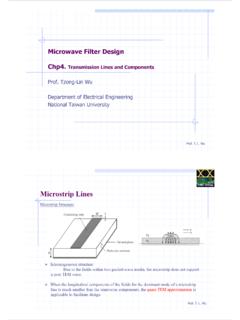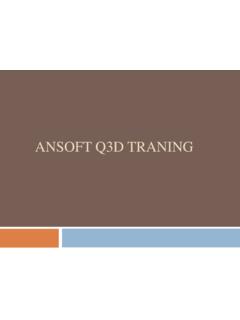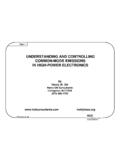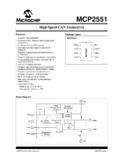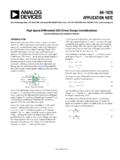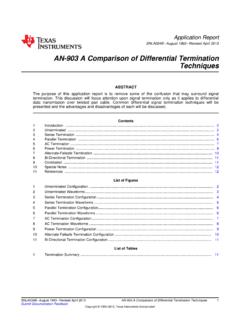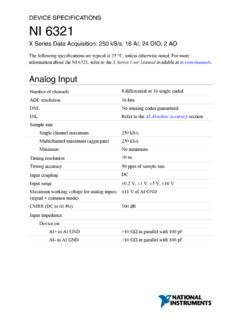Transcription of Termination techniques for high-speed digital circuits
1 1 Crosstalk Tzong-Lin Wu, Department of Electrical Engineering National Taiwan University 2 Topics: Introduction Transmission lines equations for coupled lines symmetrical lines and symmetrically driven homogeneous medium symmetrical lines in homogeneous medium symmetrical lines and asymmetrical driven Qualitative description of crosstalk Terminations Measurement of crosstalk parameters How crosstalk noise can be reduced 3 Introduction Three characteristics: of noise at near end is opposite to that at the far end. duration at near end is larger than that at the far end. magnitude at near end is smaller than that at the far end. 4 Introduction : Physical Geometry of Coupled Lines Two kind of coupling: coupling coupling 5 Introduction: cross-talk mechanism of the inductive coupling Qualitative understanding of the coupling mechanism How about the cross-talk mechanism of the capacitive coupling ?? 6 Lm Cm Lm Lm Lm Cm Cm A B C D Driving signal Forward coupling Reverse coupling Tp Tr 2Tp A B D C Tp Tr 2Tp A B D C Rise and fall times same as input Derivative of input signal (negative) Total coupled areas are the same Inductive Capacitive 7 Coupled lines equations VzVzzLztIzLztIzIzIzzCtVzzCtVzzVzzmm11112 111112()()()()()()()()()[()()]' 8 Coupled lines equations dVzdzLtIzdIzdzCtVz()()()() LllllLLLLC ccccCCCCCCCCCC mmmmmmmm LNMOQP LNMOQP LNMOQP LNMOQP LNMOQP1112212212112112221212'' Matrix forms where L 1, 2 : self-inductance per unit length of line 1 and 2 when isolated Lm : mutual inductance between line 1 and 2 C 1,2 : capacitance (to GND) of line 1 and 2 when isolated ** Cm.
2 Mutual capacitance between line 1 and 2 9 Coupled lines equations 11122122 Capacitance matrix=CCCC 11112gCCC 11122122inductance matrix=LLLL 1112121221 Capacitance matrix=NNNNCCCCCCC 1112121221 Inductance matrix=NNNNLLLLLLL For multi-conductor coupled lines 10 Coupled lines equations 110220110220()()()()j t zj t zj t zj t zV z V eV z V eI zI eI zI e 0000( )( )( )( )V zj LI zI zj CV z 202()0AV 1 1211222[]m mmmmmm mL C L CL C L CA LCL C L CL C L C 22det() 0A The can be solved with two possible solutions for nontrivial solutions 11 Symmetrical lines and symmetrical driven ()()LLCCmm11 Conditions: L1 = L2 (balanced lines) C1 = C2 The balanced lines are driven by common mode or differential mode only Characteristics: Propagation delay per-unit length: Characteristic impedance 101110111111mmemcmmomcL LkZZC CkL LkZZC Ck where magnetic coupling coefficientcapacitive coupling coefficientkLLkCCmmcm 11::12 Symmetrical lines and symmetrical driven Ze0, Zo0, 13 Symmetrical lines and symmetrical driven (Microstrip example) 14 Symmetrical lines and symmetrical driven (another definition for even and odd mode) Note: Coupling Factor = 20log(Z12) Z12 = (Ze Zo)/(Ze + Zo) 15 Physical concept for the even-mode and odd mode impedance Odd mode I1 = -I2 and V1 = -V2 odd1112gmmCCCCC 111112oddmLLLLL odd1112oddodd1112 LLLZCCC oddoddodd11121112 TDL CLLCC 16 Physical concept for the even-mode and odd mode impedance Even mode I1 = I2 and V1 = V2 even11mLLL even011mCCCC even1112eveneven1112=LLLZCCC oddeveneven11121112 TDLCLLCC 17 impedance trends for the even- and odd-modes What impedance behaviors do you see ?
3 18 impedance trends for the even- and odd-modes traces exhibit significantly more impedance variation than do the lower- impedance trace because the reference planes are much farther in relation to the signal spacing. smaller spacing, the single-line impedance is lower than the target. This is because the adjacent traces increase the self-capacitance of the trace and effectively lower its impedance even when they are not active. coupling the traces behave, the larger variation even- and odd- impedances will have. 19 Mutual coupling trends for the microstrip and stripline Mutual parasitic fall off exponentially with trace-trace spacing 20 Example by simulation: Please compare the coupling characteristics for the three cases: Ze Zo 21 22 Effect of switching patterns on transmission line Crosstalk induced flight time and signal integrity variations Switching pattern What phenomena do you see ?? 23 As the switching patterns are in even-mode: Over-driven behavior is seen (Overshooting).
4 Longer propagation delay is seen. As the switching patters are in odd-mode: Under-driven behavior is seen (Undershooting). Shorter propagation delay is seen. Why ?? Effect of switching patterns on transmission line 24 Effect of switching patterns on transmission line Even-mode pattern impedance changed from Z0 to Ze > Z0 . overdriven when Ze > Zs. Slower propagation velocity. Odd-mode pattern impedance changed from Z0 to Zodd < Z0 . under driven when Zodd < Zs. Faster propagation velocity. 25 Effect of switching patterns on transmission line Simulating traces in a multiconductor system using a single-line equivalent model (SLEM) Target trace is line 2. Please find the equivalent impedance and time delay 2212232,eff221223 LLLZCCC 2,eff221223221223 TDLLLCCC ?? 26 Effect of switching patterns on transmission line 2212232,eff221223 LLLZCCC 2,eff221223221223 TDLLLCCC 27 Example by TDR measurement: 28 Example by TDR measurement: question one ?
5 ? 29 Example by TDR measurement: question one?? Differential impedance ( ) is 150 without GND plane And about 100 with GND plane. Why ?? 30 First half: two traces refer each other like a twisted line, L and C Second half: two traces refer the GND plane, mutual coupling is quite small (km kc 0), so *Zodd 2Z0=100 31 Example by TDR measurement: question two?? What s the variation of the differential impedance For the differential pair crossing the slot ? 32 Example by TDR measurement: question two?? The gap behaves like a high impedance discontinuity which Will cause reflections. 33 Homogeneous Medium Conditions: Real (not Quasi-) TEM mode propagating on the transmission lines Characteristics: Propagation delay per-unit length: 2012121where (Coupling coefficient)mcmmmckk kkLkLLCkCC : For mutual inductance coupling : For mutual capacitance coupling 34 Symmetrical Lines on Homogeneous Medium Conditions: L1 = L2 (balanced lines) C1 = C2 The balanced lines are driven by common mode or differential mode only Characteristics: Characteristic impedance ZZZZLCeo0012111 where 35 Example: homogeneous coupled line Please compare the coupling characteristics for the three cases: 36 37 A Quiz: Please compare their Ze, Zo, Ve, Vo, and C.
6 (a) (b) 38 Symmetrical Lines and asymmetrically driven RRZRZZZZZRR eeoeoo12030000013212 (terminate even mode)terminate odd mode)(((//)) P -Terminations: VVVVVV 05051212.().()Asymmetrical driven 39 Symmetrical Lines and asymmetrically driven RRZRZZRZ oeoe12030030122 (terminate odd mode) (terminate even mode)(R2()) T - terminations 40 Imperfect Termination for Differential Transmission Line Bridge Termination AC Termination Single ended Termination are their values of the resistance? are their advantages and disadvantages ? 41 Imperfect Termination for Differential Transmission Line Bridge Termination AC Termination Single ended Termination 2Zo Zo Zo Zo Zo 42 Imperfect Termination for Differential Transmission Line Bridge: mode is completely absorbed mode is completely reflected one resistance is used. Single-ended mode is completely absorbed mode has the reflection coefficient T= (Zo Ze)/(Zo+Ze) extra damping of the even mode costs an additional resistance.
7 AC Odd mode is completely absorbed Even mode is completely reflected at low frequency, but has the reflection T = (Zo Ze)/(Zo+Ze) at high frequency. to bridge type, even mode is attenuated without increasing static power dissipation. three components. 43 Example: Termination for Differential Transmission Line 44 Example: Termination for Differential Transmission Line A simple bridge Termination 45 Example: Termination for Differential Transmission Line Differential signal is still good Common signal on each line is oscillating A simple bridge Termination , but Unbalance driving 46 Example: Termination for Differential Transmission Line Common-mode is damped A Pi- Termination for unbalance driving 47 Example: Termination for Differential Transmission Line Common-mode resonance Differential pair excited by common-mode signal 48 Example: Termination for Differential Transmission Line Single-ended Termination for Unbalanced driving Better than bridge Termination 49 Example: Termination for Differential Transmission Line AC T- Termination for Unbalanced driving 50 Example.
8 Termination for Differential Transmission Line Bridge Termination at the far end and Series Termination at the near end saving of LVDS 51 Example: Termination for Differential Transmission Line Bridge Termination at the far end and Series Termination at the near end For LVDS case 52 Example: Effects of Termination Networks on Signal-Induced EMI from the Shields of Fibre Channel Cables Operating in the Gb/s Regime 2000 IEEE EMC Symposium 53 Example: Effects of Termination Networks on Signal-Induced EMI from the Shields of Fibre Channel Cables Operating in the Gb/s Regime Measurement of S11 for both differential mode and common mode Termination effect is reduced for high frequency range 54 Example: Effects of Termination Networks on Signal-Induced EMI from the Shields of Fibre Channel Cables Operating in the Gb/s Regime differential Why the Termination effect is degraded at high frequency range ? EMI 55 Quantitative description of crosstalk Capacitive coupling Inductive Coupling VxtKxddtVtxffin(,)() VxtKVtxVtxTbbinind(,)[()()] 2 KLZCZKLZCZ fmmbmm 12141111()() (ns/cm) : Forward coupling coefficient (dimensionless) : Backward coupling coefficient If the coupled lines are symmetrical (see appendix ) 56 Quantitative description of crosstalk In the loosely coupled system (km, kc << 1) ZLCLC11111 and is accurate enough KLZCZkkKLZCZ kkfmmmcbmmmc 2214141111()()()() is clear that the backward coupling can be reduced by decreasing the mutual coupling (Lm and Cm) or by increasing the coupling to ground(L1, L2, C1, and C2).
9 Forward crosstalk is zero for two identical lines in homogeneous medium. (not easy in practical circuits ) 57 Crosstalk for a ramp step driver VtVftftTinmr()[()()] 58 Crosstalk for a ramp step driver Forward crosstalk at the far end: VltKlddtVtTKlVTTtTTffindfmrddr(,)() = , = 0 elsewhereBackward crosstalk at the near end If Tr < 2Td VtKVtVtTbbinind(,)[()()]02 VKbb,max If Tr > 2Td VlTKVKT brbmbr,max() 2 59 SPICE simulation of crosstalk 60 Measurement of coupling coefficient (Frequency domain) : (example) RAMBUS RIMM Connector Test module design 61 Measurement of coupling coefficient (Frequency domain) : RAMBUS RIMM Connector Calibration (Open, short, load ) 62 Measurement of coupling coefficient (Frequency domain) : (example) RAMBUS RIMM Connector Theory (mutual capacitance) Low freq. assumption The slope of S21(f) at low frequency is taking to compute the Cm Open circuit !! 63 Measurement of coupling coefficient (Frequency domain) : (example) RAMBUS RIMM Connector Theory (mutual inductance) Short circuit !
10 ! The slope of S21(f) at low frequency is taking to compute the Lm 64 Measurement of coupling coefficient (Frequency domain) : (example) RAMBUS RIMM Connector Measurement setup 65 Differential impedance Measurement by TDR/TDT They have good EMS (Immunity) and EMI (Interference) Performance. 66 Differential impedance Measurement by TDR/TDT Equivalent circuits of the differential interconnects: (Type I) 67 Differential impedance Measurement by TDR/TDT Equivalent circuits of the differential interconnects: (Type II) Advantage is it is a rigorous equivalent circuit. Disadvantage is only valid in three conductor interconnects. Negative impedance (not practical) 68 Differential impedance Measurement by TDR/TDT Equivalent circuits of the differential interconnects: (Type III) 69 Differential impedance Measurement by TDR/TDT Measurement Principle 70 Differential impedance Measurement by TDR/TDT Comparison of the equivalent model by the SPICE 71 A Final Question: Can you explain why 72 How to reduce crosstalk noise Space out signal routing Route-void channels adjacent to critical nets Increase coupling to ground Run orthogonal rather than parallel Provide the homogeneous medium Using the slowest risetime and falling time 73 Three conductor lines and crosstalk Time Domain Crosstalk VS Frequency-domain Crosstalk a.
